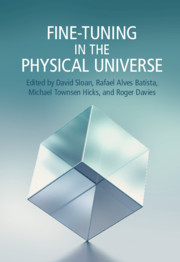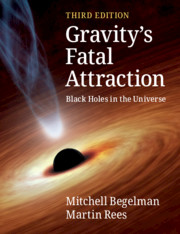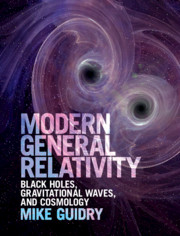Refine listing
Actions for selected content:
17000 results
2 - Hierarchy of Fine-Structure Consta
- from Part I - Introduction
-
- Book:
- Fine-Tuning in the Physical Universe
- Published online:
- 13 October 2020
- Print publication:
- 29 October 2020, pp 20-64
-
- Chapter
- Export citation
Part III - Fine-Tuning in Particle and Nuclear Physics
-
- Book:
- Fine-Tuning in the Physical Universe
- Published online:
- 13 October 2020
- Print publication:
- 29 October 2020, pp 235-236
-
- Chapter
- Export citation
Frontmatter
-
- Book:
- Fine-Tuning in the Physical Universe
- Published online:
- 13 October 2020
- Print publication:
- 29 October 2020, pp i-iv
-
- Chapter
- Export citation
9 - Dark Matter
- from Part III - Fine-Tuning in Particle and Nuclear Physics
-
- Book:
- Fine-Tuning in the Physical Universe
- Published online:
- 13 October 2020
- Print publication:
- 29 October 2020, pp 345-380
-
- Chapter
- Export citation
7 - Nuclear Physics and Its Impact on Primordial and Stellar Nucleosynthesis
- from Part III - Fine-Tuning in Particle and Nuclear Physics
-
- Book:
- Fine-Tuning in the Physical Universe
- Published online:
- 13 October 2020
- Print publication:
- 29 October 2020, pp 237-306
-
- Chapter
- Export citation
12 - On the Temporal Habitability of Our Universe
- from Part IV - Fine-Tuning for Life
-
- Book:
- Fine-Tuning in the Physical Universe
- Published online:
- 13 October 2020
- Print publication:
- 29 October 2020, pp 458-510
-
- Chapter
- Export citation
13 - Climbing Up the Theories of Nature: Fine-Tuning and Biological Molecules
- from Part IV - Fine-Tuning for Life
-
- Book:
- Fine-Tuning in the Physical Universe
- Published online:
- 13 October 2020
- Print publication:
- 29 October 2020, pp 511-538
-
- Chapter
- Export citation
Part IV - Fine-Tuning for Life
-
- Book:
- Fine-Tuning in the Physical Universe
- Published online:
- 13 October 2020
- Print publication:
- 29 October 2020, pp 381-382
-
- Chapter
- Export citation
4 - Cosmic Inflation: Trick or Treat?
- from Part II - Cosmological Fine-Tunings
-
- Book:
- Fine-Tuning in the Physical Universe
- Published online:
- 13 October 2020
- Print publication:
- 29 October 2020, pp 111-173
-
- Chapter
- Export citation
Acknowledgements
-
- Book:
- Fine-Tuning in the Physical Universe
- Published online:
- 13 October 2020
- Print publication:
- 29 October 2020, pp xi-xii
-
- Chapter
- Export citation

Fine-Tuning in the Physical Universe
-
- Published online:
- 13 October 2020
- Print publication:
- 29 October 2020

Gravity's Fatal Attraction
- Black Holes in the Universe
-
- Published online:
- 29 September 2020
- Print publication:
- 05 November 2020
-
- Textbook
- Export citation

Modern General Relativity
- Black Holes, Gravitational Waves, and Cosmology
-
- Published online:
- 25 September 2020
- Print publication:
- 03 January 2019
-
- Textbook
- Export citation

The Biological Universe
- Life in the Milky Way and Beyond
-
- Published online:
- 24 September 2020
- Print publication:
- 24 September 2020
9 - Types of Planetary System
- from Part III - Planetary Systems and Life
-
- Book:
- The Biological Universe
- Published online:
- 24 September 2020
- Print publication:
- 24 September 2020, pp 137-149
-
- Chapter
- Export citation
8 - Intelligence and Life
- from Part II - Life Here, Implications for Elsewhere
-
- Book:
- The Biological Universe
- Published online:
- 24 September 2020
- Print publication:
- 24 September 2020, pp 118-134
-
- Chapter
- Export citation
1 - A Tree with Millions of Twigs
- from Part I - Painting Big Pictures
-
- Book:
- The Biological Universe
- Published online:
- 24 September 2020
- Print publication:
- 24 September 2020, pp 3-21
-
- Chapter
- Export citation
3 - The Likelihood of Other Trees
- from Part I - Painting Big Pictures
-
- Book:
- The Biological Universe
- Published online:
- 24 September 2020
- Print publication:
- 24 September 2020, pp 38-52
-
- Chapter
- Export citation
10 - Habitable Zones
- from Part III - Planetary Systems and Life
-
- Book:
- The Biological Universe
- Published online:
- 24 September 2020
- Print publication:
- 24 September 2020, pp 150-167
-
- Chapter
- Export citation
Index
-
- Book:
- The Biological Universe
- Published online:
- 24 September 2020
- Print publication:
- 24 September 2020, pp 339-346
-
- Chapter
- Export citation
